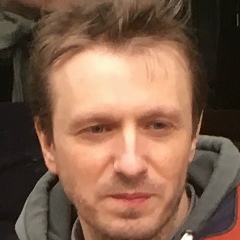#МыслиВслух
Я знаю, что вы делали прошлой осенью
Близится осень, с наступлением этого времени года начинается сезон ужасов в кинотеатрах. Хороших, плохих, ужасных в лучшей для жанра интерпретации. Да и мы вспоминаем добрым словом пару-тройку фильмов, которые в свое время заставили нас испугаться и при оптимальном раскладе еще и о чем-то задуматься. Потому что, на мой взгляд, искусство, заложенное в жанр хоррора, не сводится к тому, чтобы красиво и эффектно заявить в кадре какое-то очередное чудовище, а потом рассказать о противостоянии героев с этим монстром. Мне кажется, есть куда и глубже копнуть...
В массовой культуре за хоррорами закрепилось, прямо скажем, не самое благородное место, примерно как за боевиками Майкла Бэя. И то, и другое - жанры узконаправленные. Фильмы ужасов, в сущности, потому так и называются, что людей пугают, а, значит, насыщают адреналином, который мобилизует организм перед лицом угрозы. По-английски это называется "Fight-or-flight response" ("Бей или беги"). Надо сказать, что в каких-то продолжительных ситуациях эта штука довольно источающая и изнашивающая физиологически, но кратковременные всплески вот этих пресловутых Jump Scare, которые чаще называют "скримерами", вырабатывают нечто вроде привыкания, потому как в конце концов вызывают уже классический набор наркотических эффектов: от расширенных зрачков и ускорения сердцебиения до молниеносных рефлексов и узконаправленного туннельного зрения. А в совокупности все это работает как такой довольно полезный для нашего организма эскапизм: адреналин-то девать, по большей степени, некуда - мы больше с мамонтами врукопашную не сражаемся - и поэтому, в основном, его выработка связана теперь со стрессом или экстремальным спортом.
Так что все приёмы и изобразительные средства хорроров тесно связаны с физиологией, и примеров, когда нам пытались бы вдобавок донести каких-то умных мыслей, не так много как хотелось бы. Да, конечно, монстр доктора Франкенштейна в свое время олицетворял аморальность науки, которая создает жизнь из мертвечины и не задумывается о последствиях. Ну а киношный Дракула "Носферату" был, разумеется, символом неестественной насильственной смерти, которая стала крайне печальной нормой в годы Первой Мировой. Но в дальнейшем хорроры весьма редко котировались как умное искусство.
Чтобы разобраться в чем же на самом деле заключается главная сила монстров в фильмах ужасов,вернемся в далекий 1984-й год. Фильм, которому суждено было начать ровно 35 лет назад одну из самых известных хоррор-серий в истории - "Кошмар на улице Вязов". Впервые рассмотреть Фредди Крюгера нам позволяют в сцене, предшествующей убийству первой жертвы. Детали облика маньяка от нас еще пока скрыты - так настроено освещение намеренно - но уже есть общий силуэт, причем с ненатурально вытянутыми руками. На первый взгляд деталь совершенно бессмысленная, потому что до самого конца у Фредди с руками все нормально, однако она делает сцену невероятно жуткой, поскольку подсознательно даёт понять зрителю, что реальность, которую он наблюдает, нестабильна и находится во власти монстра.
И вот в этом и заключается главная сила хоррора - когда в абсолютно прозаичной реальности, в привычном укладе вещей внезапно появляется некий иррациональный сверхъестественный элемент, который эту реальность начинает постепенно уничтожать. Страх перед этой иррациональностью у нас возник еще в глубокой древности, когда человеку приходилось объяснять всё необъяснимое, что творилось вокруг него. Когда ясное небо внезапно сменялось грозой и ураганом, человек сразу же выдумывал себе божество, которое за это отвечало и, по идее, строило этому человеку козни.
Эту тему очень удачно обыгрывает режиссер Найт Шьямалан в одном из своих хорроров - и многими, знаю, нелюбимом - "The Village" ("Таинственный лес"). По сюжету у нас 19-й век, деревня, чьи жители жутко боятся неких чудовищ в соседнем лесу, о которых запрещено говорить. Причем с этими существами закреплён некий договор о ненападении: они живут у себя в чаще, а люди - в деревне. Все, конечно, не так просто, но вот этот запрет на обсуждение фактически цементирует в сюжете фактор устрашения, потому что людям запрещено докапываться до истины природы монстров, и остается только бояться, на чём, в общем-то, и строится всё действо. Это, само собой, повторение того самого приёма с Фредди Крюгером, так как реальность персонажей всецело зависит от сверхъестественного.
Я знаю, что вы делали прошлой осенью
Близится осень, с наступлением этого времени года начинается сезон ужасов в кинотеатрах. Хороших, плохих, ужасных в лучшей для жанра интерпретации. Да и мы вспоминаем добрым словом пару-тройку фильмов, которые в свое время заставили нас испугаться и при оптимальном раскладе еще и о чем-то задуматься. Потому что, на мой взгляд, искусство, заложенное в жанр хоррора, не сводится к тому, чтобы красиво и эффектно заявить в кадре какое-то очередное чудовище, а потом рассказать о противостоянии героев с этим монстром. Мне кажется, есть куда и глубже копнуть...
В массовой культуре за хоррорами закрепилось, прямо скажем, не самое благородное место, примерно как за боевиками Майкла Бэя. И то, и другое - жанры узконаправленные. Фильмы ужасов, в сущности, потому так и называются, что людей пугают, а, значит, насыщают адреналином, который мобилизует организм перед лицом угрозы. По-английски это называется "Fight-or-flight response" ("Бей или беги"). Надо сказать, что в каких-то продолжительных ситуациях эта штука довольно источающая и изнашивающая физиологически, но кратковременные всплески вот этих пресловутых Jump Scare, которые чаще называют "скримерами", вырабатывают нечто вроде привыкания, потому как в конце концов вызывают уже классический набор наркотических эффектов: от расширенных зрачков и ускорения сердцебиения до молниеносных рефлексов и узконаправленного туннельного зрения. А в совокупности все это работает как такой довольно полезный для нашего организма эскапизм: адреналин-то девать, по большей степени, некуда - мы больше с мамонтами врукопашную не сражаемся - и поэтому, в основном, его выработка связана теперь со стрессом или экстремальным спортом.
Так что все приёмы и изобразительные средства хорроров тесно связаны с физиологией, и примеров, когда нам пытались бы вдобавок донести каких-то умных мыслей, не так много как хотелось бы. Да, конечно, монстр доктора Франкенштейна в свое время олицетворял аморальность науки, которая создает жизнь из мертвечины и не задумывается о последствиях. Ну а киношный Дракула "Носферату" был, разумеется, символом неестественной насильственной смерти, которая стала крайне печальной нормой в годы Первой Мировой. Но в дальнейшем хорроры весьма редко котировались как умное искусство.
Чтобы разобраться в чем же на самом деле заключается главная сила монстров в фильмах ужасов,вернемся в далекий 1984-й год. Фильм, которому суждено было начать ровно 35 лет назад одну из самых известных хоррор-серий в истории - "Кошмар на улице Вязов". Впервые рассмотреть Фредди Крюгера нам позволяют в сцене, предшествующей убийству первой жертвы. Детали облика маньяка от нас еще пока скрыты - так настроено освещение намеренно - но уже есть общий силуэт, причем с ненатурально вытянутыми руками. На первый взгляд деталь совершенно бессмысленная, потому что до самого конца у Фредди с руками все нормально, однако она делает сцену невероятно жуткой, поскольку подсознательно даёт понять зрителю, что реальность, которую он наблюдает, нестабильна и находится во власти монстра.
И вот в этом и заключается главная сила хоррора - когда в абсолютно прозаичной реальности, в привычном укладе вещей внезапно появляется некий иррациональный сверхъестественный элемент, который эту реальность начинает постепенно уничтожать. Страх перед этой иррациональностью у нас возник еще в глубокой древности, когда человеку приходилось объяснять всё необъяснимое, что творилось вокруг него. Когда ясное небо внезапно сменялось грозой и ураганом, человек сразу же выдумывал себе божество, которое за это отвечало и, по идее, строило этому человеку козни.
Эту тему очень удачно обыгрывает режиссер Найт Шьямалан в одном из своих хорроров - и многими, знаю, нелюбимом - "The Village" ("Таинственный лес"). По сюжету у нас 19-й век, деревня, чьи жители жутко боятся неких чудовищ в соседнем лесу, о которых запрещено говорить. Причем с этими существами закреплён некий договор о ненападении: они живут у себя в чаще, а люди - в деревне. Все, конечно, не так просто, но вот этот запрет на обсуждение фактически цементирует в сюжете фактор устрашения, потому что людям запрещено докапываться до истины природы монстров, и остается только бояться, на чём, в общем-то, и строится всё действо. Это, само собой, повторение того самого приёма с Фредди Крюгером, так как реальность персонажей всецело зависит от сверхъестественного.
#Thinking out loud
I know what you did last fall
Autumn is approaching, with the onset of this time of year, the season of horror in theaters begins. The good, the bad, the ugly in the best interpretation for the genre. Yes, and we remember with a kind word a couple of films, which at one time made us scared and, in the optimal scenario, also think about something. Because, in my opinion, the art inherent in the genre of horror is not limited to beautifully and effectively declaring some next monster in the frame, and then telling about the confrontation of the heroes with this monster. It seems to me that there is much and deeper to dig ...
In popular culture, horror movies have been, frankly, not the most noble place, just like the militants of Michael Bay. Both are narrow genres. Horror films, in fact, are called so because they frighten people, and, therefore, saturate with adrenaline, which mobilizes the body in the face of a threat. In English, this is called "Fight-or-flight response" ("Fight or flight"). I must say that in some prolonged situations this thing is quite oozing and wearing out physiologically, but short-term bursts of these notorious Jump Scare, which are more often called "screamers", develop something like addiction, because in the end they cause already a classic set of narcotic effects : from dilated pupils and accelerated heartbeat to lightning-fast reflexes and narrow tunnel vision. Taken together, all this works as such a rather useful escapism for our body: adrenaline, for the most part, has nowhere to go - we no longer fight hand-to-hand with mammoths - and therefore, basically, its production is now associated with stress or extreme sports.
So all the techniques and pictorial means of horror are closely related to physiology, and there are not so many examples when they would try to convey to us in addition some clever ideas as we would like. Yes, of course, Dr. Frankenstein's monster at one time personified the immorality of science, which creates life from the dead and does not think about the consequences. Well, the cinematic Dracula "Nosferatu" was, of course, a symbol of an unnatural violent death, which became an extremely sad norm during the First World War. But later on, horror films were rarely quoted as clever art.
To understand what the main power of monsters in horror films really is, let's go back to the distant 1984th year. The film, which was destined to start exactly 35 years ago, one of the most famous horror series in history - "A Nightmare on Elm Street". We are allowed to see Freddy Krueger for the first time in the scene preceding the murder of the first victim. The details of the maniac's appearance are still hidden from us - this is how the lighting is intentionally set up - but there is already a general silhouette, and with unnaturally outstretched arms. At first glance, the detail is completely meaningless, because until the very end, Freddie's hands are fine, but it makes the scene incredibly creepy, because it subconsciously makes it clear to the viewer that the reality that he is observing is unstable and dominated by a monster.
And this is the main power of horror - when in an absolutely prosaic reality, in the usual way of things, a certain irrational supernatural element suddenly appears, which gradually begins to destroy this reality. The fear of this irrationality has arisen in our minds in ancient times, when a person had to explain everything inexplicable that was happening around him. When the clear sky was suddenly replaced by a thunderstorm and a hurricane, a person immediately invented a deity for himself, who was responsible for this and, in theory, intrigued this person.
This theme is played very well by director Night Shyamalan in one of his horror films - and many, I know, unloved - "The Village" ("Mysterious Forest"). According to the plot, we are in the 19th century, a village whose inhabitants are terribly afraid of certain monsters in the neighboring forest, which are forbidden to talk about. Moreover, a kind of non-aggression pact is fixed with these creatures: they live in their more often, and people - in the village. Everything, of course, is not so simple, but this ban on discussion actually cements the factor of intimidation in the plot, because people are forbidden to get to the bottom of the truth of the nature of monsters, and all that remains is to be afraid, on what, in general, the whole action is based. This, of course, is a repetition of that very technique with Freddy Krueger, since the reality of the characters is entirely dependent on the supernatural.
I know what you did last fall
Autumn is approaching, with the onset of this time of year, the season of horror in theaters begins. The good, the bad, the ugly in the best interpretation for the genre. Yes, and we remember with a kind word a couple of films, which at one time made us scared and, in the optimal scenario, also think about something. Because, in my opinion, the art inherent in the genre of horror is not limited to beautifully and effectively declaring some next monster in the frame, and then telling about the confrontation of the heroes with this monster. It seems to me that there is much and deeper to dig ...
In popular culture, horror movies have been, frankly, not the most noble place, just like the militants of Michael Bay. Both are narrow genres. Horror films, in fact, are called so because they frighten people, and, therefore, saturate with adrenaline, which mobilizes the body in the face of a threat. In English, this is called "Fight-or-flight response" ("Fight or flight"). I must say that in some prolonged situations this thing is quite oozing and wearing out physiologically, but short-term bursts of these notorious Jump Scare, which are more often called "screamers", develop something like addiction, because in the end they cause already a classic set of narcotic effects : from dilated pupils and accelerated heartbeat to lightning-fast reflexes and narrow tunnel vision. Taken together, all this works as such a rather useful escapism for our body: adrenaline, for the most part, has nowhere to go - we no longer fight hand-to-hand with mammoths - and therefore, basically, its production is now associated with stress or extreme sports.
So all the techniques and pictorial means of horror are closely related to physiology, and there are not so many examples when they would try to convey to us in addition some clever ideas as we would like. Yes, of course, Dr. Frankenstein's monster at one time personified the immorality of science, which creates life from the dead and does not think about the consequences. Well, the cinematic Dracula "Nosferatu" was, of course, a symbol of an unnatural violent death, which became an extremely sad norm during the First World War. But later on, horror films were rarely quoted as clever art.
To understand what the main power of monsters in horror films really is, let's go back to the distant 1984th year. The film, which was destined to start exactly 35 years ago, one of the most famous horror series in history - "A Nightmare on Elm Street". We are allowed to see Freddy Krueger for the first time in the scene preceding the murder of the first victim. The details of the maniac's appearance are still hidden from us - this is how the lighting is intentionally set up - but there is already a general silhouette, and with unnaturally outstretched arms. At first glance, the detail is completely meaningless, because until the very end, Freddie's hands are fine, but it makes the scene incredibly creepy, because it subconsciously makes it clear to the viewer that the reality that he is observing is unstable and dominated by a monster.
And this is the main power of horror - when in an absolutely prosaic reality, in the usual way of things, a certain irrational supernatural element suddenly appears, which gradually begins to destroy this reality. The fear of this irrationality has arisen in our minds in ancient times, when a person had to explain everything inexplicable that was happening around him. When the clear sky was suddenly replaced by a thunderstorm and a hurricane, a person immediately invented a deity for himself, who was responsible for this and, in theory, intrigued this person.
This theme is played very well by director Night Shyamalan in one of his horror films - and many, I know, unloved - "The Village" ("Mysterious Forest"). According to the plot, we are in the 19th century, a village whose inhabitants are terribly afraid of certain monsters in the neighboring forest, which are forbidden to talk about. Moreover, a kind of non-aggression pact is fixed with these creatures: they live in their more often, and people - in the village. Everything, of course, is not so simple, but this ban on discussion actually cements the factor of intimidation in the plot, because people are forbidden to get to the bottom of the truth of the nature of monsters, and all that remains is to be afraid, on what, in general, the whole action is based. This, of course, is a repetition of that very technique with Freddy Krueger, since the reality of the characters is entirely dependent on the supernatural.




У записи 4 лайков,
0 репостов,
178 просмотров.
0 репостов,
178 просмотров.
Эту запись оставил(а) на своей стене Michael Polishchuk

























